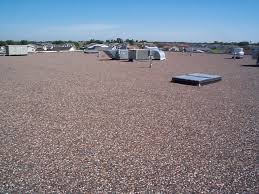 During the 1950s, America hummed with energy, optimism and a desire to leave the hard times of the past behind. Furniture, homes, fashion, automobiles and even art began to veer away from the traditional and embrace a modernistic tone. These trends continued throughout most of the 1960s as well. One movement that was very much in vogue during these two decades was the construction of homes with flat or low-slope gravel roofs. These types of roofs soon fell out of fashion for homes, however, primarily due to the unique problems that they presented.
During the 1950s, America hummed with energy, optimism and a desire to leave the hard times of the past behind. Furniture, homes, fashion, automobiles and even art began to veer away from the traditional and embrace a modernistic tone. These trends continued throughout most of the 1960s as well. One movement that was very much in vogue during these two decades was the construction of homes with flat or low-slope gravel roofs. These types of roofs soon fell out of fashion for homes, however, primarily due to the unique problems that they presented.
What most people call a gravel roof is a type of built-up roof that contains layers of hot asphalt and roofing felt. There are seldom more than five layers; four is considered average, but some homes have gravel roofs with only three layers. Each new layer of felt is pressed into the hot asphalt below before a new layer is installed. Once all of the layers are in place, gravel is installed over the top.
What Problems Are Associated With Gravel Roofs?
When low-slope gravel roofs fell out of favor, many roofers eliminated the special equipment and additional insurance required to install them. Therefore, the first problem you may encounter is finding a legitimate, reputable contractor with experience installing, maintaining and repairing these roofs.
Flat gravel roofs require regular inspections; it is best to have them inspected twice each year. Leaf debris can collect on low-slope roofs, and rotting vegetation will reduce the roof’s life. Moss can begin to grow, shortening the roof’s life even more.
If you have a low-slope gravel roof, plan to have gravel replaced frequently. The area along the ridge is prone to gravel loss, which leaves the asphalt exposed and susceptible to damage from UV radiation. Once the asphalt breaks down, leaks can develop and cause damage to the interior and/or the building’s structural components.
Ponding is a common problem with flat gravel roofs. As a rule, any puddles of water that remain on the roof more than 48 hours after it stops raining are a problem. Standing water increases the risk of water penetrating to the roof decking or home’s interior, but it also provides a convenient location for mosquitoes to lay their eggs.
As the roof ages, the asphalt can develop alligator cracks. These cracks are typically interconnected and resemble the scale pattern on the back of an alligator or crocodile. Water enters through these cracks and goes to work on the layers below, deteriorating the felt. In addition, when the sun warms the water trapped between the layers, blisters or raised pockets will form. Typically, blisters loosen the gravel and dislodge it from the area. Without the gravel, the area becomes more prone to damage, increasing the risk of leaks.
Another problem with low-slope gravel roofs is that it can be very difficult to locate a leak. Leaks can develop around vent pipes, skylights and flashings as well as at points where the roof meets a wall. In the event of a leak, the water frequently travels several feet from the actual point of the leak before it manifests as a stain on the ceiling.
Where to Find Help
Alpha Roofing Industries can assist you with all of your roofing needs. We are a well-respected Austin commercial roofing company serving Austin and Central Texas area with a variety of services, including asphalt shingle installation, roof repairs, metal roofing systems, roof inspections, moss and debris removal, flat roof replacement and skylight installation. We also install siding. If you need exceptional work at competitive rates, contact Alpha for a free quote by submitting the online form or calling (512) 777-1086.
